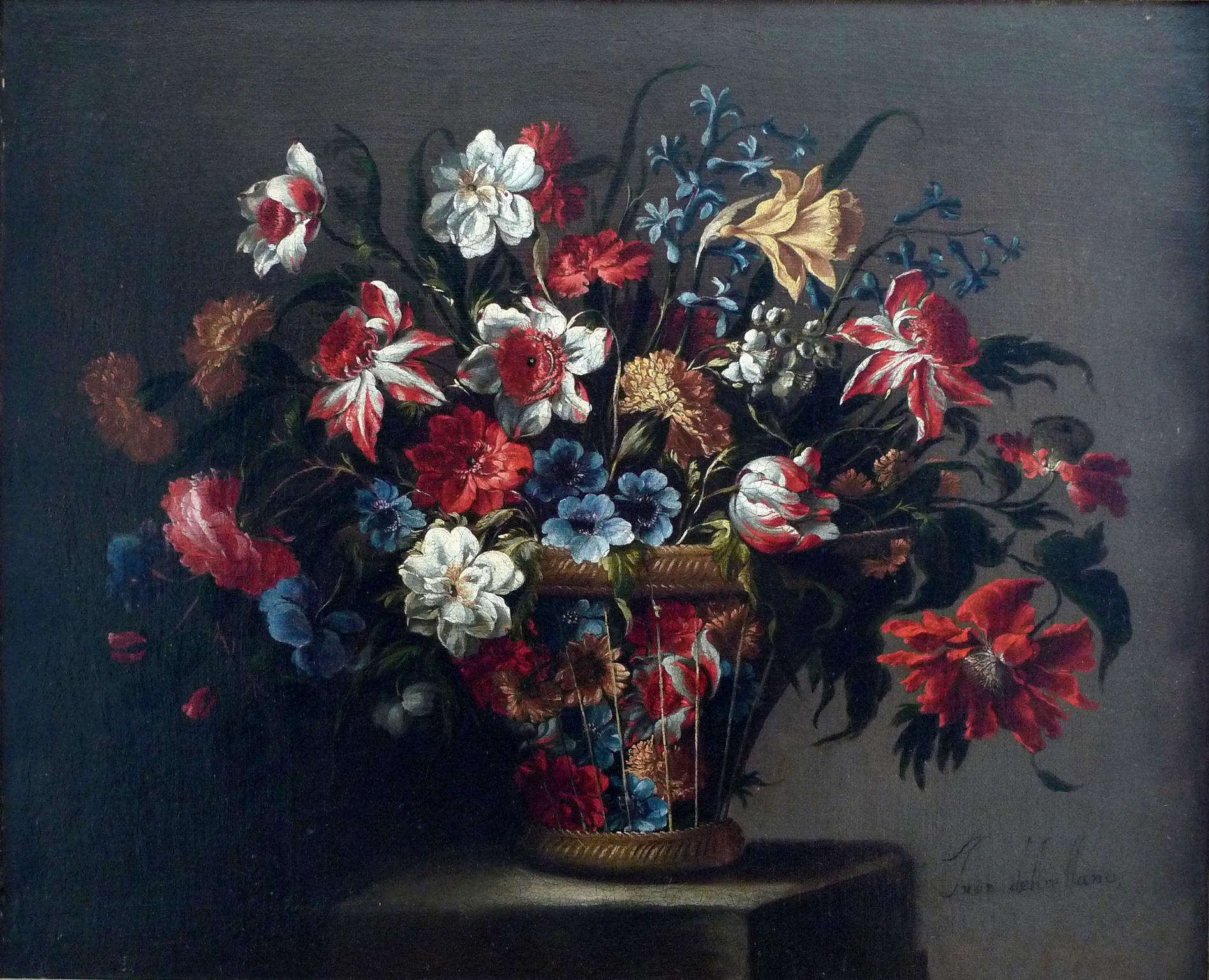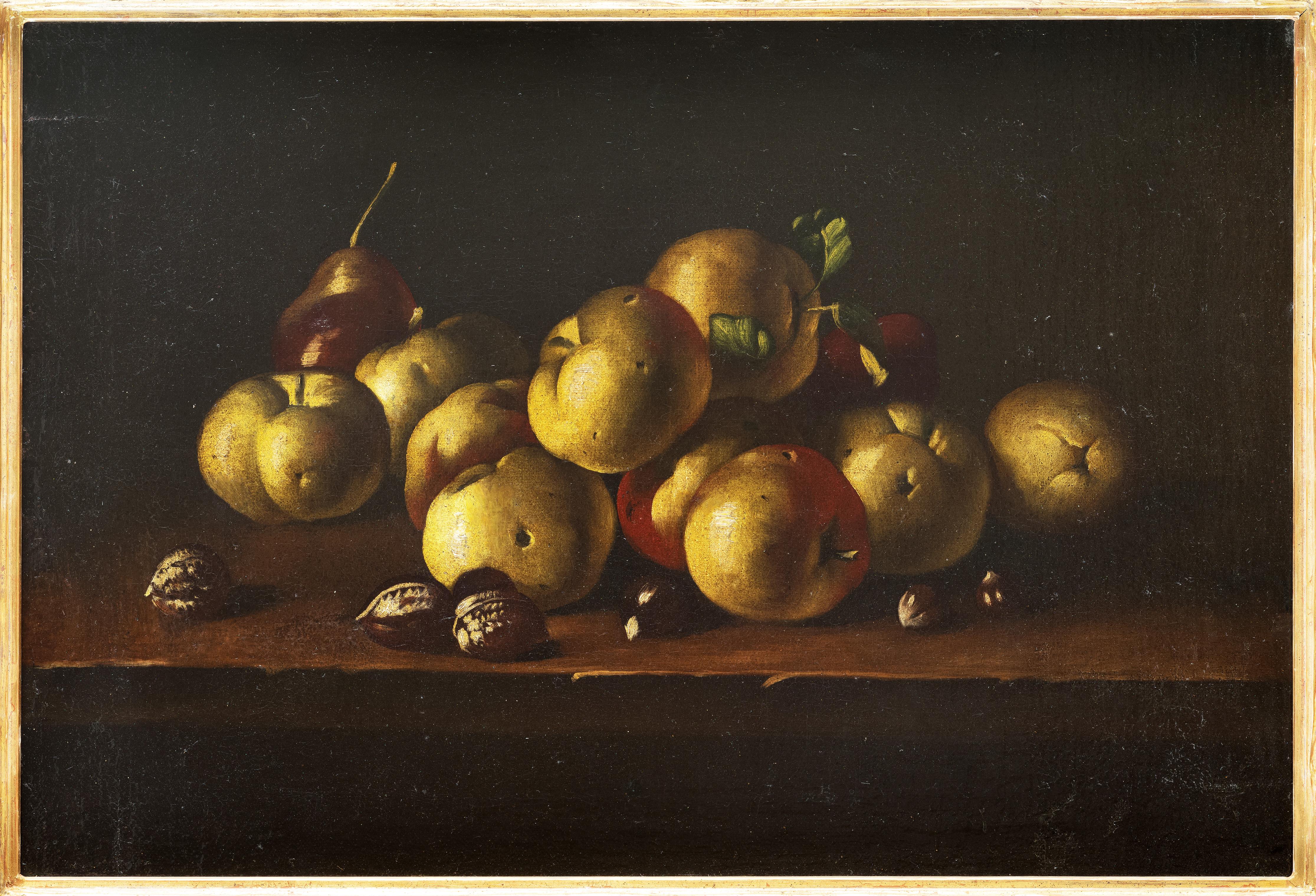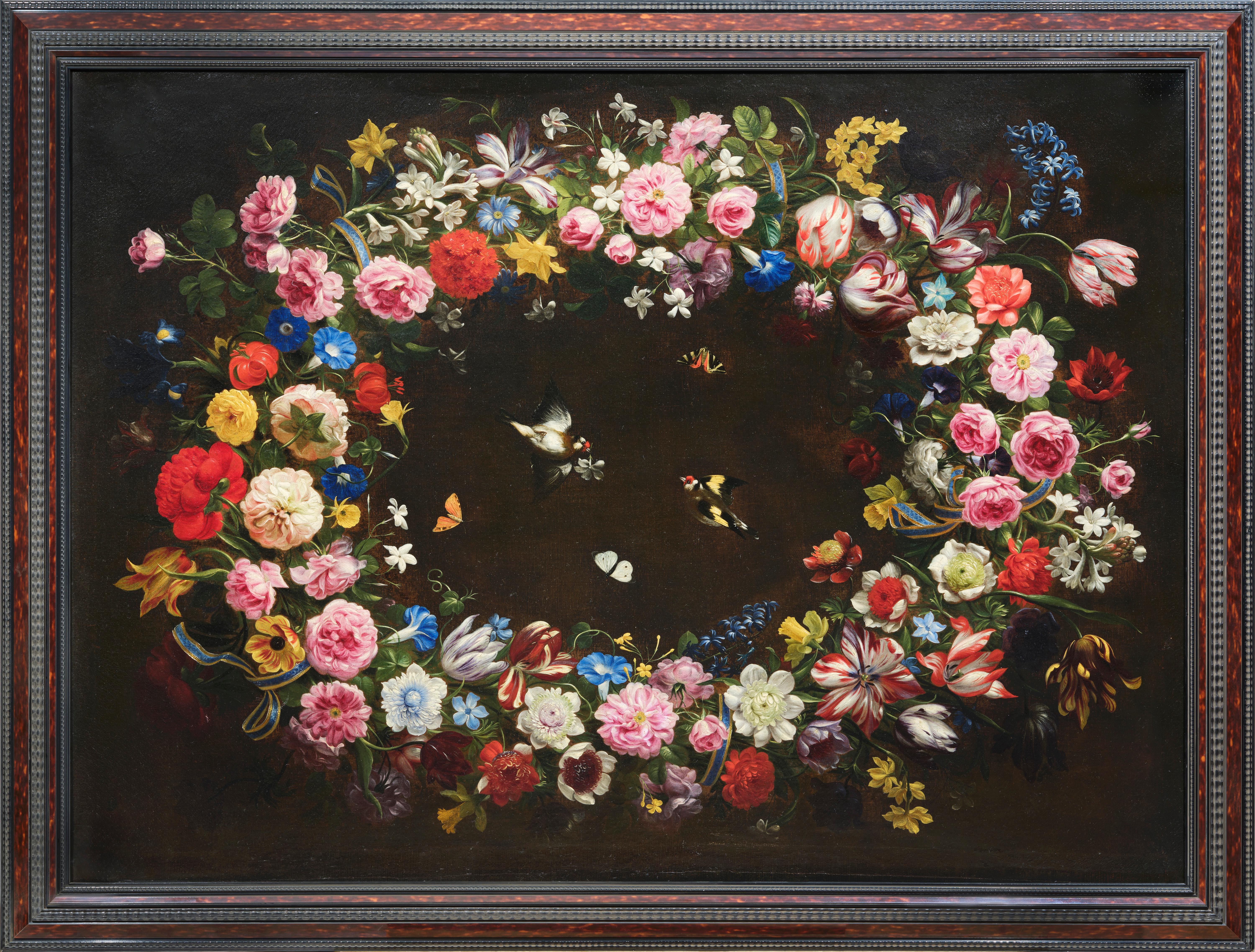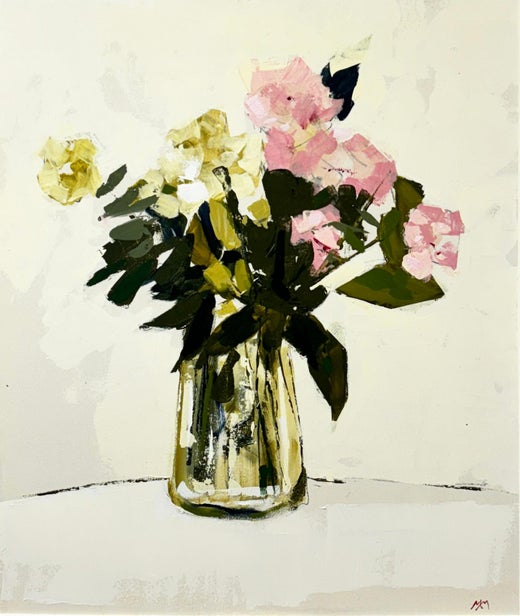Items Similar to Flowers on White
Want more images or videos?
Request additional images or videos from the seller
1 of 7
Martin MooneyFlowers on White2023
2023
About the Item
Flowers on White
Oil on Board
61 x 50.8 cm
24 x 20 in
Regarded as one of Ireland’s most accomplished fine art painters, Martin Mooney was born in 1960, in Belfast, Northern Ireland.
Mooney graduated from the Brighton College of Art & Design and the prestigious Slade School of Fine Art, where he completed his Masters in Fine Art painting. Mooney’s outstanding technical ability, together with his keenness to look to the past for inspiration, has gained him appreciation over the years from a number of admirers including his tutors at Slade, Euan Uglow and Sir Lawrence Gowing. He also gained attention from the London Evening Standard’s art critic Brian Sewell who had written an essay, in 1990 for Mooney’s first solo exhibition at Dublin’s Solomon Gallery and spoke glowingly of this ‘fine painter with a natural intelligence’ who had taken up the mantle of the past. Since his first solo exhibition, Mooney has had numerous sell-out exhibitions in Dublin, London, Toronto and New York.
Mooney has been known to build up his paintings using glazed layers, often bathed in a golden hue. Whether his paintings are set in Dublin or Venice, Gerona or Donegal they all have a similarity. He paints architecture, countryside and still life using enriched tones, rich reds and pale blues.
In an exhibition in 2007, at the James Adam Auctioneers in Dublin, Mooney gave a new desire to paint floral still life and landscapes of Donegal. He wanted to challenge himself as an artist and create new subject matters, which has led him to be an even more accomplished painter.
Now based in rural Donegal, Mooney’s landscapes are informed by his absorption of plein air painting. His billowing cloud formations and insertions of unexpected colour epitomise Mooney’s new relationship with colour and form, along with a new sense of fluidity and freedom.
1960 Born Belfast, Northern Ireland.
1979-80 University of Ulster, Faculty of Art and Design
1980-83 Brighton Polytechnic College of Art and Design; BA Honours Fine Art
1983-85 University College London, The Slade School of Fine Art (Post Graduate)
Awards include:
- 1983 Emily Lucy Boyce Travel Scholarship, Brighton Faculty of Art
- 1985 Richard Ford Award, The Royal Academy, London
- 1987 George Campbell Memorial Grant, Arts Council of Ireland, Arts of Northern Ireland and the Spanish Cultural Institute, Dublin
- 1992 Adams Salesrooms Choice of Artist for Future Appreciation Award, Royal Hibernian Academy, Dublin
- 1997 Completed ten large paintings for the Merrion Hotel, Dublin
- 2001 Appointed official artist for HRH The Prince of Wales Royal Tour of the Baltic States
- 2003 Appointed official artist for HRH The Prince of Wales Royal Tour of Russia
Works held in private collections in Ireland, United Kingdom, France, Guernsey, Spain, The Netherlands, Switzerland, USA, Canada, South Africa, Morocco, Australia and Hong Kong.
- Creator:Martin Mooney (1960, Irish)
- Creation Year:2023
- Dimensions:Height: 24.02 in (61 cm)Width: 20.01 in (50.8 cm)
- More Editions & Sizes:UniquePrice: $9,370
- Medium:
- Movement & Style:
- Period:
- Condition:
- Gallery Location:Belfast, GB
- Reference Number:
Martin Mooney
Regarded as one of Ireland’s most accomplished fine art painters, Martin Mooney was born in 1960, in Belfast, Northern Ireland. Mooney graduated from the Brighton College of Art & Design and the prestigious Slade School of Fine Art, where he completed his Masters in Fine Art painting. Mooney’s outstanding technical ability, together with his keenness to look to the past for inspiration, has gained him appreciation over the years from a number of admirers including his tutors at Slade, Euan Uglow and Sir Lawrence Gowing. He also gained attention from the London Evening Standard’s art critic Brian Sewell who had written an essay, in 1990 for Mooney’s first solo exhibition at Dublin’s Solomon Gallery and spoke glowingly of this ‘fine painter with a natural intelligence’ who had taken up the mantle of the past. Since his first solo exhibition, Mooney has had numerous sell-out exhibitions in Dublin, London, Toronto and New York.
Mooney has been known to build up his paintings using glazed layers, often bathed in a golden hue. Whether his paintings are set in Dublin or Venice, Gerona or Donegal they all have a similarity. He paints architecture, countryside and still life using enriched tones, rich reds and pale blues.
In an exhibition in 2007, at the James Adam Auctioneers in Dublin, Mooney gave a new desire to paint floral still life and landscapes of Donegal. He wanted to challenge himself as an artist and create new subject matters, which led him to be an even more accomplished painter.
Now based in rural Donegal, Mooney’s landscapes are informed by his absorption of plein air painting. His billowing cloud formations and insertions of unexpected colour epitomise Mooney’s new relationship with colour and form, along with a new sense of fluidity and freedom. 1960 Born Belfast, Northern Ireland. 1979-80 University of Ulster, Faculty of Art and Design
1980-83 Brighton Polytechnic College of Art and Design; BA Honours Fine Art
1983-85 University College London, The Slade School of Fine Art (Post Graduate) Awards include: 1983 Emily Lucy Boyce Travel Scholarship, Brighton Faculty of Art
1985 Richard Ford Award, The Royal Academy, London
1987 George Campbell Memorial Grant, Arts Council of Ireland, Arts of Northern Ireland and the Spanish Cultural Institute, Dublin
1992 Adams Salesrooms Choice of Artist for Future Appreciation Award, Royal Hibernian Academy, Dublin
1997 Completed ten large paintings for the Merrion Hotel, Dublin
2001 Appointed official artist for HRH The Prince of Wales Royal Tour of the Baltic States
2003 Appointed official artist for HRH The Prince of Wales Royal Tour of Russia
2017 Completed commission of 12 paintings for a house in Merrion Square. Works in private collections in Ireland, United Kingdom, France, Guernsey, Spain, The Netherlands, Switzerland, USA, Canada, South Africa, Morocco, Australia and Hong Kong.
About the Seller
No Reviews Yet
Vetted Seller
These experienced sellers undergo a comprehensive evaluation by our team of in-house experts.
Established in 1990
1stDibs seller since 2023
- ShippingRetrieving quote...Ships From: Belfast, United Kingdom
- Return PolicyA return for this item may be initiated within 3 days of delivery.
More From This SellerView All
- MarshmallowsLocated in Belfast, GBMarshmallows Oil on Canvas 31 1/8 x 31 1/8 in 79 x 79 cm adf0358 "Overtime, French Le-Roy became heavily influenced by the Dutch and Spanish still life painters, particularly the work of Williem Kalf and Luis Melendez. This took his work from a contemporary style to a more traditional genre. This proved popular, leading to more commissioned work, and a second successful exhibition." Irish still life painter David French...Category
2010s Old Masters Still-life Paintings
MaterialsOil
- Meet Me @ DawnLocated in Belfast, GBMeet Me @ Dawn, 2019 Signed and dated on reverse Oil on Canvas 35 3/8 x 23 5/8 in 90 x 60 cm "The quirky manner in which Johnston pulls and twists narratives, highlighted by the realistic nature of his work, sheds light on the camouflaged absurdities hiding in plain sight. Johnston invites the viewer to dig through the layers of mundane normality with the shovel of imagination to unearth new perspectives." - Saatchi Art (2023) Award winning artist Stephen Johnston...Category
2010s Surrealist Abstract Paintings
MaterialsOil
- Portrait of AmbitionLocated in Belfast, GBPortrait of ambition Oil on Canvas 39 3/8 x 27 1/2 in 100 x 70 cm "The quirky manner in which Johnston pulls and twists narratives, highlighted by the realistic nature of his work, sheds light on the camouflaged absurdities hiding in plain sight. Johnston invites the viewer to dig through the layers of mundane normality with the shovel of imagination to unearth new perspectives." - Saatchi Art (2023) Award winning artist Stephen Johnston...Category
2010s Photorealist Portrait Paintings
MaterialsOil
- Portrait of consequenceLocated in Belfast, GBPortrait of consequence Oil on Canvas 35 3/8 x 23 5/8 in 90 x 60 cm "The quirky manner in which Johnston pulls and twists narratives, highlighted by the realistic nature of his work, sheds light on the camouflaged absurdities hiding in plain sight. Johnston invites the viewer to dig through the layers of mundane normality with the shovel of imagination to unearth new perspectives." - Saatchi Art (2023) Award winning artist Stephen Johnston...Category
2010s Photorealist Portrait Paintings
MaterialsOil
- Spring FlowersBy Martin MooneyLocated in Belfast, GBThis is an oil on panel painting in Martin Mooney's signature frame. Regarded as one of Ireland’s most accomplished fine art painters, Martin Mooney was born in 1960, in Belfast, No...Category
2010s Contemporary Still-life Paintings
MaterialsOil, Panel
- Autumn FlowersBy Martin MooneyLocated in Belfast, GBThis is an oil on panel painting in Martin Mooney's signature frame. Regarded as one of Ireland’s most accomplished fine art painters, Martin Mooney was born in 1960, in Belfast, No...Category
2010s Contemporary Still-life Paintings
MaterialsPanel, Oil
You May Also Like
- Still Life with Fishes and Oysters - Oil on Canvas - 17th CenturyLocated in Roma, ITStill life with fishes and oysters is an original oil on canvas realized in the 17th Century by Neapolitan School Master. Impressive in size as well as for its vivid representation o...Category
17th Century Old Masters Still-life Paintings
MaterialsOil
- De Wit Flowers Still life Paint Oil on canvas 18th Century Flemish Cupids ArtLocated in Riva del Garda, ITJacob De Wit (Amsterdam, 1695 - 1754) attributable/ workshop Pair of Cupids with Garland of Flowers Oil on canvas 91 x 103 cm. - Framed 104 x 115 cm. Provenance: Christie's (London, Old master Painting 12.12.1996) lot 82 This magnificent composition depicts two cupids holding a garland of flowers, placed on a fine architecture with bas-reliefs and masks, presumably the top of a fountain. One of the two cupids sympathetically holds a part of it with his hands, while his head turns towards the viewer; the second cupid, on the other hand, must have clumsily broken the thread holding its end, and is sitting sullenly with a torch and a tear streaking his chubby cheek. The work, given its stylistic features and compositional taste, can be attributed to the Flemish artist Jacob de Wit (Amsterdam, 1695 - 1754), or to an artist from his workshop, with his typical triumphal and opulent style, which reveals clear influences from Rubens and Van Dijck, but also from Gerard de Lairesse...Category
18th Century Old Masters Paintings
MaterialsOil
- "Cesta de flores", 17th Century Oil on Canvas, Still Flowers by Juan de ArellanoBy Juan de ArellanoLocated in Madrid, ESJUAN DE ARELLANO Spanish, 1614 - 1676 Cesta de Flores signed Juan de Arellano (lower lright) oil on canvas original period carved, gilt and polychrome...Category
17th Century Old Masters Still-life Paintings
MaterialsCanvas, Oil
- A gentleman’s vicesLocated in London, GBEnglish School, circa 1827 A gentleman’s vices the newspaper dated ‘Sunday December 23 1827’ (upper left) oil on canvas 20 ¾ x 24 ½ in. (52.7 x 62.3 cm.) frame 25 ⅝ x 29 ¼ in. (65.1...Category
Early 19th Century Old Masters Still-life Paintings
MaterialsCanvas, Oil
- Still Life with Apples and Nuts, 17th Century, Old Master, Spanish PaintingLocated in Greven, DEJuan Sánchez Cotán (1560 - 1627) was one of the most important still life painters in Spain and beyond. He developed a certain type of still life with a ...Category
17th Century Old Masters Still-life Paintings
MaterialsCanvas, Oil
- Flower Garland by Giovanni Stanchi, the most Flemish Italian flower painterBy Giovanni StanchiLocated in PARIS, FRThis painting is reproduced in the reference book on Roman still life "Pittori di nature morta a Roma - artisti italiani 1630 -1750" by Gianluca and Ulisse Bocchi - Arti Grafiche Castello 2005 (page 250 figure FS5), where it is mentioned as one of the few paintings that can be given with certainty to Giovanni Stanchi. This highly decorative flower garland reveals a very strong Flemish influence, enabling us to attribute it with certainty to Giovanni Stanchi, the eldest of a sibling group of painters active in the production of still lifes in 17th century Rome. Probably painted before 1640, our garland conceals a mystical message beneath its decorative opulence, which we're about to reveal ... 1. Giovanni, Niccolò and Angelo Stanchi, a brotherhood of still-life painters in 17th-century Baroque Rome The three Stanchi brothers, Giovanni (1608 - after 1675), Niccolò (ca. 1623 - 1690) and Angelo (1626 - after 1675) lived and worked together (like the Le Nain brothers), making identification of the different hands perilous. Giovanni Stanchi's name is first mentioned in 1634, in the register of the painters' guild of the "Accademia di San Luca". Paid membership of the painters' guild provided not only a social network, but also commissions from important Roman families. In 1638, Giovanni Stanchi painted a picture for the Barberini family depicting their coat of arms surrounded by flowers. In 1660, he was commissioned by Cardinal Flavio Chigi to decorate a gallery with still lifes of flowers and fruit. The Chigis remained his principal patrons until after 1673. Thereafter, he received commissions from almost every important family in Rome. An invoice dated 1670 identifies Giovanni Stanchi and Mario Nuzzi as the painters responsible for the still lifes that decorated the famous mirrors in Palazzo Colonna. In 1675, Giovanni Stanchi's name appears for the last time in connection with a project in which he was engaged, together with Andries Bosman and the figure painter Ciro Ferri, to decorate the mirrors of the Palazzo Borghese on Campo Marzio. Although all three brothers were active as painters, the records of their commissions always refer to Giovanni, since, as eldest brother, he was responsible for invoices and contracts. Only in a few cases is the name of one of the younger brothers mentioned. Only paintings with a strong Flemish influence dating from the first four decades of the 17th century, such as this one, can be attributed with certainty to Giovanni, as he was the only painter in the family at the time. 2. History of a genre: the flower garland Jan Brueghel the Elder (Brussels 1568 - Antwerp 1625) is credited with inventing the flower garland theme during his stay in Rome in 1592. Such garlands were originally used to surround a religious subject, often a Marian one. This religious scene could sometimes be painted by another artist, as in the painting acquired in 1608 by Cardinal Borromeo, featuring a Madonna (painted by Henry van Balen), surrounded by a garland painted by Jan Brueghel. This theme was taken up and developed in Rome from 1625 onwards by Daniel Seghers, before the young Giovanni Stanchi made it his own, reinforcing its symbolic dimension (to which we shall return) and moving away from the naturalistic approach of Jan Brueghel to develop a certain idealization of each flower, closer to the style of Mario Nuzzi (Rome 1603 - 1673). Giovanni Stanchi's garlands, of which he was the best Italian interpreter in the 17th century, also reveal him to be one of the most faithful to the Flemish tradition. The book by Gianluca and Ulisse Bocchi lists nine still lifes very similar to ours, all executed on a black background (including the one reproduced as the last photo in the gallery, which belongs to the Pinacoteca Nazionale in Bologna). Because of their proximity to Flemish works, they can be attributed with certainty to Giovanni Stanchi. Four of them belong to private collections, while the others are all in public institutions (Anhaltische Gemäldegalerie, Dessau; Galeria del Palazzo Bianco, Genoa; Musée des Beaux-Arts, Bordeaux; Pinacoteca Nazionale, Bologna; Palazzo Chigi-Saraceni, Siena). Like those in Flemish still lifes, the flowers depicted by Giovanni Stanchi bloom at different times of the year, ruling out any representation of a real bouquet. Alongside the more traditional flowers of our gardens (roses, tulips, hyacinths, daffodils, irises), it is also interesting to note the frequent inclusion of more exotic flowers such as jasmine and blue bindweed (ipomoea indica), which had been recently introduced to Europe from Mexico. Each flower painted by Giovanni Stanchi seems to have its own individuality, a trait characteristic of Flemish painting, of which Stanchi was the best interpreter in Italy. One could say that Stanchi does not depict garlands of flowers, but flowers in a garland, each with its own identity and specificity, making it unique and different from the others. Captured in a low-angled light that seems to have captured them for eternity, they are drawn with clear, precise lines. As if they had been freshly cut, they emerge from the darkness in geometric figures that reinforce the tactile quality of their representation. One of Giovanni Stanchi's distinctive features is to have substituted the central religious representation traditionally associated with Flemish flower...Category
17th Century Old Masters Still-life Paintings
MaterialsCanvas, Oil
Recently Viewed
View AllMore Ways To Browse
Swiss Still Life
Framed Flower Set
Red Flower Large Art
Spain Old Masters
Old Spanish Master
Old Masters Venice
Russian Old Masters
Spain Old Master Paintings
Spanish Old Master Paintings
Martin Grant
Old Master Paintings Venice
Old Masters Paintings Of Venice
Irish Flowers
Flower Of South Africa
Adam Flowers
James Hong
Bath Oil Painting Masters
1987 Countryside





